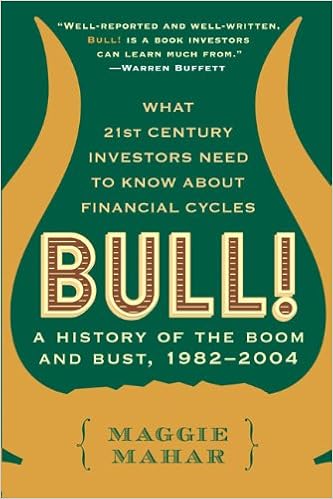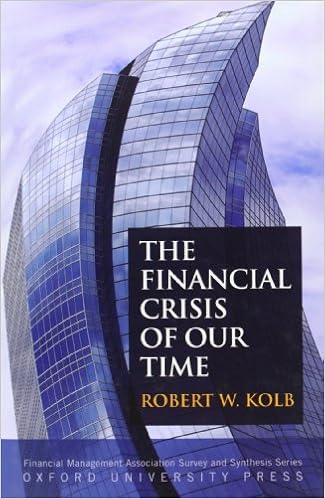By Maggie Mahar
In 1982, the Dow hovered less than one thousand. Then, the marketplace rose and speedily received velocity until eventually it peaked above 11,000. famous journalist and fiscal reporter Maggie Mahar has written the 1st e-book at the extraordinary bull industry that begun in 1982 and ended simply within the early 2000s. for nearly twenty years, a colourful forged of characters resembling Abby Joseph Cohen, Mary Meeker, Henry Blodget, and Alan Greenspan got here to dominate the industry news.
This within examine that 17-year cycle of development, equipped upon interviews and extraordinary entry to crucial analysts, marketplace observers, and fund managers who eagerly inform the stories of excesses, offers the interval with a ancient standpoint and explains what rather occurred and why.
Quick preview of Bull: A History of the Boom and Bust, 1982-2004 PDF
Similar Finance books
The Complete Idiot's Guide to Personal Finance in Your 20s & 30's
You're no fool, after all. You're financially self reliant: You pay hire, utilities, and loans all from your personal paycheck. you already know that your mom and dad needed to lower the wire eventually, and you're happy with how good you've adjusted. but if it involves saving cash for the lengthy haul, you are feeling like an astronaut whose oxygen twine has been lower.
The choice solution by means of Bob Rice is the 1st booklet to give an explanation for the hot international of different making an investment recommendations, displaying the way to use those new items for inflation-protected source of revenue, risk-adjusted progress, and long term wealth move. The Yale Endowment retains in simple terms 6% of its investments in US shares, yet its portfolio has produced a a hundred% achieve over the last decade.
Way of the Turtle: The Secret Methods that Turned Ordinary People into Legendary Traders
“We're going to elevate investors similar to they elevate turtles in Singapore. ”
So buying and selling guru Richard Dennis reportedly stated to his long-time buddy William Eckhardt approximately 25 years in the past. What begun as a chance approximately even if nice investors have been born or made grew to become a mythical buying and selling test that, before, hasn't ever been informed in its entirety.
Way of the Turtle finds, for the 1st time, the explanations for the luck of the secretive buying and selling process utilized by the crowd referred to as the “Turtles. ” Top-earning Turtle Curtis religion lays naked the total test, explaining the way it used to be attainable for Dennis and Eckhardt to recruit 23 usual humans from all walks of existence and educate them to be remarkable investors in exactly weeks.
Only nineteen years previous on the time-the youngest Turtle through far-Faith traded the most important account, making greater than $30 million in precisely over 4 years. he is taking you backstage of the Turtle choice technique and in the back of closed doorways the place the Turtles realized the profitable buying and selling thoughts that enabled them to earn a regular go back of over eighty percentage according to yr and earnings of greater than $100 million. You'll detect
* How the Turtles made money-the rules that guided their buying and selling and the step by step tools they undefined * Why, even supposing they used an analogous method, a few Turtles have been extra winning than others * the way to glance past the principles because the Turtles applied them to discover center ideas that paintings for any tradable marketplace * how one can follow the Turtle method to your individual trades-and on your personal lifestyles * how you can diversify your buying and selling and restrict your publicity to threat
Offering his precise viewpoint at the adventure, religion explains why the Turtle means works in smooth markets, and stocks richly deserved knowledge on taking dangers, deciding on your personal course, and studying out of your mistakes.
The Financial Crisis of Our Time (Financial Management Association Survey and Synthesis)
In 2006 residential actual property costs peaked and commenced to fall, then threatened the world's monetary associations in 2007, and faced the worldwide financial system with catastrophe in 2008. long ago few years, thousands of individuals have misplaced very gigantic parts in their wealth. And whereas the markets have rebounded significantly, they're nonetheless faraway from an entire restoration.
- Behavioral Finance and Wealth Management: How to Build Optimal Portfolios That Account for Investor Biases
- Handbook of Exchange Rates (Wiley Handbooks in Financial Engineering and Econometrics, Volume 2)
- The Essential Retirement Guide: A Contrarian's Perspective
- The Economist (06 April 2013)
- The Independent (15 September 2015)
- Entrepreneurial Finance (2nd Edition)
Extra resources for Bull: A History of the Boom and Bust, 1982-2004
They may not be procuring shares, yet no less than they have been holding the money of their Schwab money owed. “Black Monday did to traders what Jaws did to swimmers,” Schwab saw. “They don’t are looking to cross within the water, yet they nonetheless come to the seashore. ”34 because the crash of 1987 grew to become a misty reminiscence, heritage will be rewritten. The revisionists might declare that whereas specialist investors panicked, the small investor stood pat. stories of the small traders’ braveness grew to become a cornerstone of the foremost populist fantasy of the nineties: that the “little man” used to be smarter than the professional. (Warren Buffett “just didn’t get it”; the dentist who watched CNBC whereas drilling did. ) the reality was once yr after the crash, mutual fund traders have been nonetheless guidance away from shares. 35 web revenues of fairness cash have been just a 3rd of what that they had been a 12 months prior. in the meantime, at constancy, redemptions had tired the firm’s fairness money: earlier than Black Monday, money that invested in shares boasted resources of approximately $47. 6 billion; 5 months later that they had shrunk to $34. eight billion. after all, the various shrinkage used to be because of industry losses, yet by means of February of ’88 the industry used to be creating a great restoration. but resources in Fidelity’s fairness cash remained down 27 percentage from their precrash degrees. 36 Mutual fund redemptions didn't carry the Dow down, yet that was once in simple terms simply because mutual fund traders weren't significant gamers within the fairness marketplace. because the eighties drew to an in depth, small traders grew to become much more wary. Insider buying and selling scandals roiled Wall highway, and by means of 1989, many have been confident that the industry used to be a online game run by way of those that should be defined, so much charitably, as “too shrewdpermanent through part. ” Public participation within the inventory marketplace, measured as a percent of loved ones resources invested in shares or fairness money, stood a ways less than its 1968 height. 37 What would it not take to restore the people’s marketplace of the overdue sixties? “It’s a weird time,” Merrill Lynch’s Bob Farrell stated overdue in 1988. “So a lot exposure is given to those who make loads of money—whether it’s a man who wins the lottery or an funding banker, and Wall road has been in the midst of it. Bonfire of the Vanities sums it up. Now if the normal of dwelling is going down, or if there's a decline within the worth of housing, extra humans may be trying to find how to ‘score. ’ If the little man perspectives equities as a speculative online game, he should be likely to play it if he feels that he has to discover the way to collect wealth. ”38 In different phrases, it might probably take challenging instances to deliver small traders again in. Farrell had some degree. the second one leg of the People’s industry wouldn't commence in earnest until eventually 1991, whilst the economic climate used to be in recession and rates of interest on funds industry money had slipped to good under five percentage. basically then did person traders start to take into consideration purchasing shares. THE AFTERMATH: ON WALL road (1987–89) because the eighties trailed off, a malaise hung over the road. “No one desires a nook office,” confided a tender government at Merrill Lynch.





